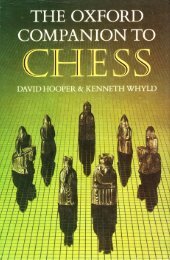You also want an ePaper? Increase the reach of your titles
YUMPU automatically turns print PDFs into web optimized ePapers that Google loves.
308 SHINKMAN<br />
pay no artention <strong>to</strong> this gruesne prool oI his<br />
succ.sstul bid for power until he had linished his<br />
same. His so., ofrhe sane.ame (d.908). was one<br />
ot tbe Poets whose works were edited <strong>by</strong> assnt,<br />
wno gives the following poem.<br />
O thou whos crri. sneeB expEss<br />
Thc ccnsurc oI oui lavourilc .he$-<br />
Its play distaction lion dinres;<br />
ft counsels *adon in rhen d.<br />
When dang.* rbicai, and poih prcsi<br />
Add ynld. us. shen ve need rhem mon<br />
C.mp ions ln our luneIoes.<br />
SI!INKIIi,{N, WILLIAM ANTHONY ( 1847<br />
1933), one oI the greatest l*o Amencan conpos<br />
els of the 191h century. Sam royD N6 the olheri<br />
bul Shinknanwas nore thorough in hiswork and<br />
nore proli6c. He is credited with lheinvention of<br />
the nrsl nulale Gee BLoc(), in 1877. wlile<br />
European composers were largely concemedwith<br />
DIEo GE orthodox problems Shinkman developed<br />
the sELnAE and several new ideasr his<br />
wd the principal influe.@ that kindled DAwsoN\<br />
inlerest in r^ny moELrMs. Shinkman wasbrought<br />
from Bohemia <strong>to</strong> the USA when he was sixilate.<br />
he becane an insuran@ agent, . properly agent,<br />
and, in 1893, City Clerk of Cmnd Rapids,<br />
Mchigan, where he lived throDghonthis adull lifc<br />
and <strong>to</strong> *hi.h he owed his nickname 'ihe wizard of<br />
C'and Rapids. (see ANNrHrunoN; plcuNrNNt.)<br />
A. c. \Nhite, <strong>The</strong> Gotdd Atsory (1929).onrains<br />
600 probleds <strong>by</strong> Shinkman.<br />
SEOGI, the Generals Game. is Japanesc <strong>chess</strong>.<br />
Alihotrgh probably troh the sane aces<strong>to</strong>r as<br />
intemadonal <strong>chess</strong> shoei is unlike any other<br />
regionalvariation. Tbe unchequer€d board h.s 9 x<br />
9 squares. Each playerhas twentypieces (which, in<br />
shogi. ircltrdes pawn, a@nged al rhe slari ol play<br />
as lolloNs lron lelt ro .ight: 66t rank, lance,<br />
knight, sitv6. gold, king, gold, silver, k.ight,<br />
lanei semnd rank, a bishop on tbe second 6le, a<br />
rook on rhe eightb frleithirdrank, ninepaMs. <strong>The</strong><br />
gold, si,v.r, and king were onginauy gold general.<br />
silver ge.eral. and jewelled general hencc the<br />
Generals Gane. <strong>The</strong> king is 6oved like a <strong>chess</strong><br />
king, the gold like a king but not <strong>to</strong> the two squares<br />
diagonauy lo iis iear, the silver one squaredirectly<br />
foN.rds or one square in any dia8onal dnection.<br />
thetnightlikea <strong>chess</strong>knight(i.e. ilisa LEApER) but<br />
only <strong>to</strong> the one or l*o squares tbal lienostnearly<br />
sirai8ht ahead, the lan@ like a rook but only<br />
forward and only on its own file. <strong>The</strong> paMs a.e<br />
moved directly forward one squarc at a ride and<br />
lhey capture in the sane way. A player has the<br />
option olpromoting any piece. othei than his king<br />
or golds, when they are moved in<strong>to</strong>,vithin, or out<br />
oflhe last three ranks: tbe pawns,lances. knights,<br />
Shqi, the inilial aiiay shown on a pocket scl<br />
andsilvers 6ay be promoted <strong>to</strong> golds: the rook and<br />
bishop add the powe6 of ihe king <strong>to</strong> their ownbe.omine<br />
coMurN.D prEcrs Captured piees<br />
chang€ sidesr the caplor holdsthem in (ese e ( in<br />
hand') a.d he nay, with some limitations, drop'<br />
then ar any nne wbere bechooseson the board in<br />
lieu of making a novei dropped pieces lose any<br />
powe6 lhey may prerioustt, havc eained <strong>by</strong><br />
pronotion. <strong>The</strong> object of ihe gane is <strong>to</strong> checkmaie<br />
rhe opponenfs king. Tbe special fearures ol<br />
promotion and dropping hale i.fluenced the<br />
design oI lhe nen. <strong>The</strong>se a.e all ihe same shape,<br />
thin, iat, and 6ve sided wirh one pointed end.<br />
Ow.eship is determined <strong>by</strong> rhe way rhe piees are<br />
placed o. thc board, ea.h player poinins the<br />
pieces in his diredion ol play. <strong>The</strong> nature ol thc<br />
piece is marked on the lace and its promoted<br />
-v.reion on lhe reverse side.<br />
BecaNe pawns lacins onc anothe! are mutuauy<br />
en pr6c, strategy ol rhe kind lamiliar <strong>to</strong> playeB of<br />
inlemariodal cbessis le$ in evidenceiand because<br />
pieccs arc continually reappeanng, edd8anes in<br />
the <strong>chess</strong> sense do not occur. tn A Baok ol Chels<br />
(1973) c. H. oD. vho advocaled<br />
shogi- said n {.s nore ^LEuNDEI. lactical and less positional<br />
lhan ihe iniernalional same. Probablv no other<br />
regional vanation n as poputd in its ountry !s<br />
shogi. Anobstacle <strong>to</strong>nswideracceptanceisth€ use<br />
of ideoCrans, nany bearing a narked resenblane<br />
<strong>to</strong> rhose used in Chinese che$, <strong>to</strong> idenrily rhe<br />
Piees, although Westemized pieces can be found<br />
which sive the ioitial lerter (in Roman) oI each<br />
piece and a symbol showine rhe narure ofih no!e.<br />
Tbere are other versions. Tbe best knoNn is<br />
Middle Shogi which uses a 12 x 12 board and 46<br />
pieceson each sidc <strong>The</strong>re are 1vo <strong>to</strong>ms ot Gieat<br />
Shoei, on a 13 x 13 boardsith 3,1pieces oron a 15<br />
x 15 board silh 65 piees each. tnrger versions<br />
have a 19 x 19board wnh 96 pieces each. ora25 x<br />
25 board witn 1?7 pieces each.




